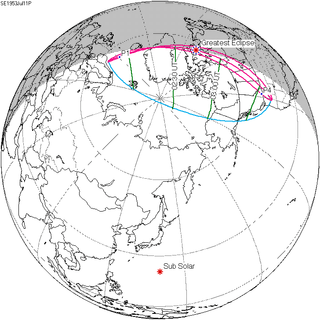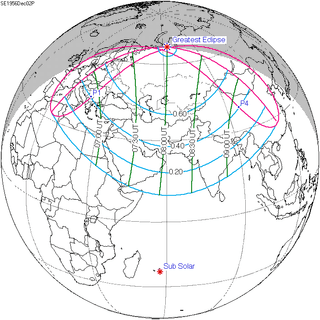Solar eclipse of June 8, 1956
| Solar eclipse of June 8, 1956 | |
|---|---|
 Map | |
| Type of eclipse | |
| Nature | Total |
| Gamma | -0.8934 |
| Magnitude | 1.0581 |
| Maximum eclipse | |
| Duration | 285 sec (4 m 45 s) |
| Coordinates | 40°48′S 140°42′W / 40.8°S 140.7°W |
| Max. width of band | 429 km (267 mi) |
| Times (UTC) | |
| Greatest eclipse | 21:20:39 |
| References | |
| Saros | 146 (24 of 76) |
| Catalog # (SE5000) | 9412 |
A total solar eclipse occurred on June 8–9, 1956. A solar eclipse occurs when the Moon passes between Earth and the Sun, thereby totally or partly obscuring the image of the Sun for a viewer on Earth. A total solar eclipse occurs when the Moon's apparent diameter is larger than the Sun's, blocking all direct sunlight, turning day into darkness. Totality occurs in a narrow path across Earth's surface, with the partial solar eclipse visible over a surrounding region thousands of kilometres wide. It began near sunrise over New Zealand on June 9th, and ended west of South America on June 8th.
Related eclipses
Solar eclipses of 1953-1956
Each member in a semester series of solar eclipses repeats approximately every 177 days and 4 hours (a semester) at alternating nodes of the Moon's orbit.
Note: Partial solar eclipse of February 14, 1953 and August 9, 1953 belong to the last lunar year set.
| Solar eclipse series sets from 1953–1956 | ||||
|---|---|---|---|---|
| Descending node | Ascending node | |||
| Saros | Map | Saros | Map | |
| 116 |  July 11, 1953 Partial |
121 |  January 5, 1954 Annular | |
| 126 |  June 30, 1954 Total |
131 |  December 25, 1954 Annular | |
| 136 |  June 20, 1955 Total |
141 |  December 14, 1955 Annular | |
| 146 |  June 8, 1956 Total |
151 |  December 2, 1956 Partial | |
Notes
References
- Earth visibility chart and eclipse statistics Eclipse Predictions by Fred Espenak, NASA/GSFC
| Wikimedia Commons has media related to Solar eclipse of 1956 June 8. |
